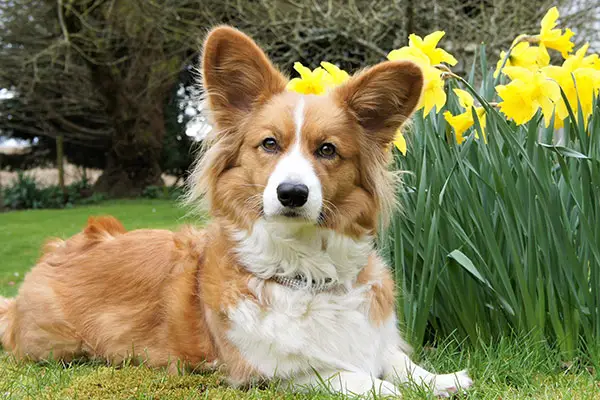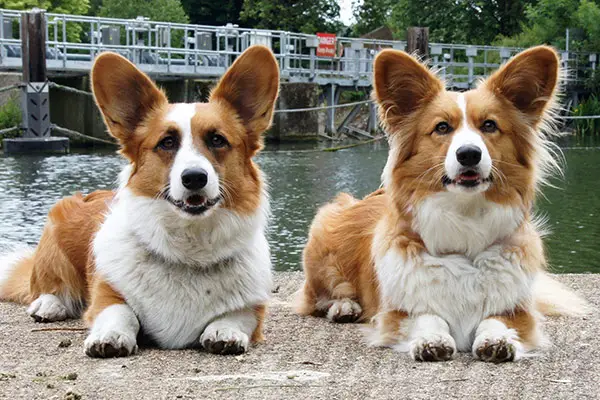The Cardigan Welsh Corgi is another breed of Welsh Corgi that is larger than the Pembroke Welsh Corgis. These dogs stand at the height of 12.5 inches maximum. They have a sturdy bone, short legs, a deep chest with coats that come in various colors – red to blue-merle. The most distinguishable characteristic of the Cardigan Welsh is its long, thick tail and round ears.

Cardigan Welsh Corgi Statistics
| Dog Breed Group | Herding |
| Breed Size | Medium |
| Height | 10.5-12.5 inches |
| Weight | 30-38 pounds (male); 25-34 pounds (female) |
| Lifespan | 12-15 years |
Cardigan Welsh Corgi Ratings
| Energy level | |
| Exercise needs | |
| Requires attention | |
| Playfulness | |
| Trainability | |
| Shedding | |
| Grooming | |
| Friendly with family | |
| Friendly with kids | |
| Friendly with strangers | |
| Friendly with other dogs | |
| Prey Drive |
Related Article: Best Dog Food for Corgis
Cardigan Welsh Corgi History
The Cardigan Welsh Corgi is believed to be older than the Pembroke one. These dogs are known to have existed around 1200 BC in Wales. They were brought by the Celtic tribes who migrated from Central Europe.
The Cardigans were developed as an all-around farm-dog in Wales. They helped in herding, guarding, and driving cattle during the day, and they were excellent human companions at night. Farmers treasured them as they were essential in their financial well-being. They loved the dogs so much that penalties were given to anyone who would harm or steal one of these dogs.
It was in 1919 when Cardigan Welsh Corgis were first shown in English dog shows. By 1926, the English Cardigan Welsh Corgi Association was founded. But at that time, the Pembroke and Cardigans were still considered as one breed.
It was only in 1931 when the two breeds were separated, and immediately the next year, the American Kennel Club officially recognized the dog breed. At around the same time, the Cardigan Welsh Corgi Club was founded too.
Now, the Cardigan Welsh Corgi ranks 68th popular dog breed in the US. These dogs also excel in dog shows with a few appearances in the movies.
Temperament
The American Kennel Club describes the Cardigan Welsh Corgi as affectionate, loyal, and smart. At present, Cardigans don’t herd cattle anymore, but their instinct for it remains. They are tough working dogs and are happier if given something to do.
With their enthusiastic personality, they need to have an outlet to spend their energy. If given enough exercise, they’ll be great indoor companions and won’t cause any problems.
Cardigan dogs are generally adaptable and easy to live with. They are excellent family companions and are great friends for children. They also do well with other pets, especially if you have livestock or horses.
These dogs are also known to be territorial with animals they don’t know. They are also less friendly, so you can expect them to be reserved towards strangers. They make excellent watchdogs and will bark if he detects anything suspicious.
Training may turn out challenging for the Cardigan Welsh Corgi. They are known to be independent thinkers and would find a way to get what he wants. They need someone who is firm and confident to make him obey.
Early socialization would help in making them more well-rounded dogs. Expose them to different people, sights, and sounds before they turn four months old, so they’re more accustomed to it.

Care Requirements
- Nutrition: Cardigan Welsh Corgis needs a high-quality meal that contains a great balance of essential nutrients. They need food that is rich in protein, such as animal meat. It would be best if you only buy high-quality ingredients for your dogs. If you’re going for commercial dog food, you should go for the premium quality ones. It also shouldn’t contain fillers and additives that would cause problems for your dog’s digestion.
- Grooming: Cardigan Welsh Corgis have short coats that shed at least twice a year. Their coat needs brushing at least once a week to keep it looking healthy. During the shedding season, you might need to brush it daily to get rid of loose hair and prevent it from spreading around your house. Trimming their hair is also a great way to keep them looking their best. For baths, you can give the Cardigans one bath every few months, depending on his activities or how dirty he gets. These dogs don’t emit dog odor that much, so it’s alright not to bath them too frequently. Nails should be trimmed regularly and must never be allowed to grow too long. This can be painful and will cause a lot of discomforts. As for the ears, these must be checked and cleaned regularly to prevent ear infections from happening.
- Exercise: Cardigans are known to be adaptable dogs. They are great outdoor and indoor companions, whichever you prefer. Regular exercise is needed to keep them happy. They thrive for socialization, so daily walks should suffice for this dog breed. They also love running around but make sure that you have a secured fence if you want to get them off-leash. If you have livestock that they can herd, then they’ll be happier. As a Cardigan Welsh Corgi parent, one thing you should avoid is jumping and stairs. This can strain their backs and may cause back injuries.
- Health: For the Cardigan Welsh Corgis, there are only two significant diseases you need to watch out for – the Intervertebral Disk Disease and Progressive Retinal Atrophy. The former is brought about by their long backs, which makes them prone to spinal ruptures, while the latter causes blindness.
- Lifespan: The life expectancy of Cardigan Welsh Corgis is 12-15 years.
Famous Cardigan Welsh Corgis
- Cassie: One of the first Cardigan Welsh Corgis brought to the United States
- Megan: Cassie’s puppy; First US champion of the Cardigan dog breed
Fun Facts about Cardigan Welsh Corgis
- Cardigan Welsh Corgis were first found in Cardiganshire around 1200 BC, hence where they got their name.
- They were originally used to drive and herd cattle.
- They were treasured dogs; an ancient welsh law made to punish anyone who will harm and steal these dogs.
- They were recognized by the American Kennel Club in 1935.
- They had three different group designations – from Non-Sporting Group to Working Group to Herding Group.
- They have a tail compared from their Pembroke counterpart that is known to be tailless.
Check Out Other Herding Dog Breeds:
Australian Cattle Dog, Australian Shepherd, Bearded Collies, Beaucerons, Belgian Malinois, Belgian Sheepdog, Belgian Tervuren, Bergamasco Sheepdog, Berger Picards, Border Collie, Bouviers des Flandres, Briards, Canaan Dog, Collie, Entlebucher Mountain Dogs, Finnish Lapphund, German Shepard, Miniature American Shepherd, Norwegian Buhunds, Old English Sheepdog, Pembroke Welsh Corgi, Polish Lowland Sheepdogs, Puli, Pumi, Pyrenean Shepherd, Shetland Sheepdog, Spanish Water Dog, Swedish Vallhunds
